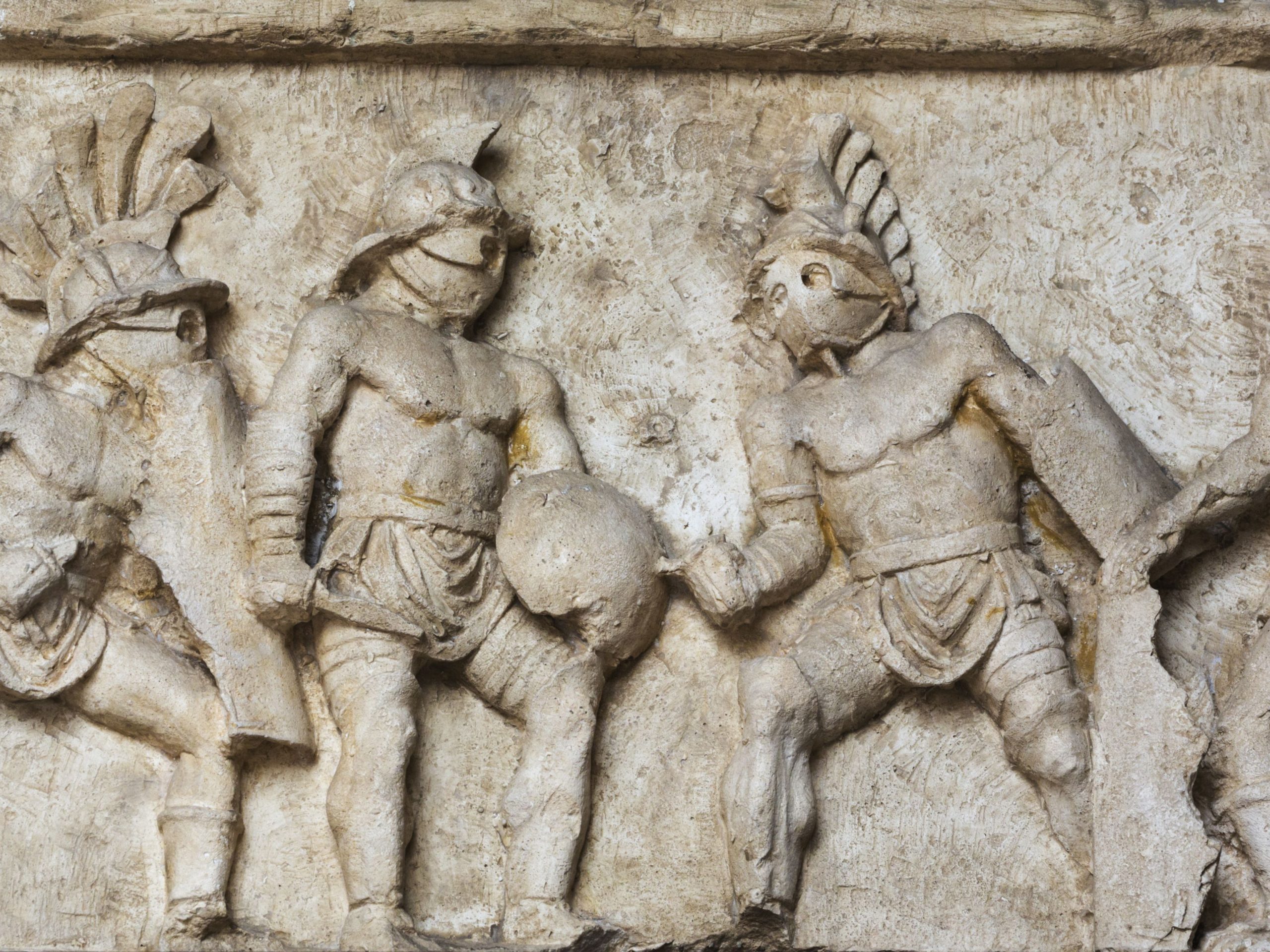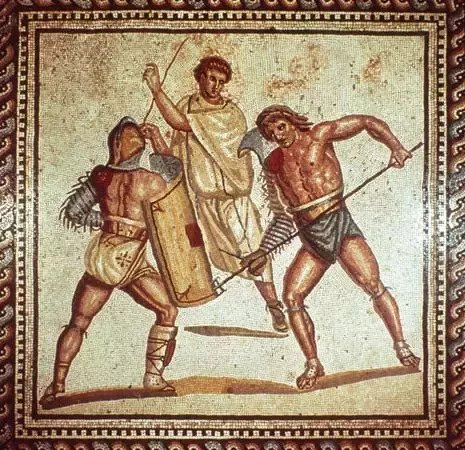
The Gladiators of the Colosseum
When we visit the colosseum, the main reference we have for the men who fought in the arena is from Hollywood. Ridley Scott’s movie Gladiator starring Russell Crowe as Maximus with rippling muscles actually doesn’t do too bad a job at portraying the life of a gladiator. Maximus is captured far away from his home and enslaved, sold by slave traders to a gladiator school (managed by Oliver Reed). He impresses his manager and the crowd with his fighting skills, women throw themselves at him and he eventually makes it to Rome to fight where he becomes an overnight sensation. How close to the reality is this? Probably not too far!
Gladiatore in Latin means swordsman, named after a standard issue thrusting short-sword called the Gladius. Originally used at funerals or munera to honour the dead, Gladiatorial combat for entertainment was already popular by the 1st century BC. Over a century later, amphitheatres would be built all over the empire to satisfy the people’s newfound interest in the gladiatorial games.
Who were the gladiators?
Originally, they were prisoners-of-war, slaves and criminals, later even volunteers who were down on their luck or were seeking fame. With its rapid military expansion Rome had a ready supply of prisoners of war – these men already had fighting experience and so could be trained up in little time to be gladiators. The games were big business and for a lanista or manager taking an ordinary man and turning him into a gladiator was a waste of time and money. We should think less of fodder for the arena and more of trained, skilled fighters who put on a show much like our boxing, fencing and wrestling today.
There were several different types of gladiator classified by costume and fighting style, some of the earlier types reflected early enemies of Rome like the Samnites and the Thracians, they wore similar armour and used their specific fighting styles. In times of peace the game’s needed a steady supply of criminals, who had to have powerful physiques and know how to fight. Criminals could be sentenced to the courts or thrown to the beasts; a lesser penalty was to be trained in the Gladiator schools – being a gladiator gave some hope of survival.
Gladiators were big money like footballers today
On average men were chosen between 18-20 years old, like our sports stars today, by 30 they were all washed up. A gladiator signed a contract of five years, they won prize money and at the end of their service would gain their freedom (if they weren’t dead). The lanista was much like a football manager

today (they took a cut from the winnings). Gladiators were a valuable commodity; they had to be housed and fed, given armour, trained and attended to by a doctor if they were sick or injured – think of them like racehorses, an investment.
Training was with wooden weapons and wicker shields that were heavily weighted to build muscle and develop control. Their diet was heavy in carbohydrates like barley and beans to bulk them up – much like bodybuilders today. The aim was to cover the well-honed muscles with a protective layer of fat; fatty flesh produces a lot of blood but does little damage.
The gladiators lived in a barracks consisting of single celled rooms surrounding a training arena in the centre. Behind the colosseum part of the Ludus Magnus still exists, this was the largest of four such training arenas which had a passage that connected to the colosseum. This whole area (today covered by restaurants and posh hotels) was a complex of service buildings built by the emperor Domitian. The complex had four training arenas, an armoury, a hospital, morgue and even a butcher – the animals were cut up and fed to the other animals or perhaps even to the crowd. Why not an ostrich burger for lunch?
Was it always to the death?
The Gladiators were too expensive to kill, especially the big stars who pulled the crowds. In Rome there was a permanent team of Gladiators for the games, but in smaller venues around the Roman Empire they would be hired from travelling troupes. A fee was arranged for the rent of the gladiator and if he was killed the cost was doubled. Gladiators were taken between 18 and 20, they could expect to live until their mid-twenties if they made it to 30 – they were all washed up much like our footballers today.
Nobody came here to see hack and slash. This was just like boxing, wrestling, fencing today. The spectators came to see a good fight, a skilled fight. Ancient Rome was a violent place, this entertainment instilled good Roman values like military prowess, bravery in the face of death and courage on the battlefield.
Like our contact sports today, there was a referee – something we don’t see in the movie Gladiator! The gladiators fought in pairs that were equally matched; like boxing today, a featherweight would not be paired with a heavyweight! A mosaic from Germany and a funerary relief (at the colosseum) clearly show a referee, unfortunately, we don’t know the rules, but they were there to make sure no one was harmed too quickly. We know from funerary inscriptions around one in nine or one in twelve bouts ended in serious injury or death.
There were many types of gladiators, the big stars who probably only fought once or twice a year and the lower level gladiators who were more likely to lose their life or be sacrificed for the spectacle – but in general death wasn’t the point!
Sports stars and Sex symbols
The Gladiators were well loved like the sports stars and sex symbols of our day. Images of gladiators have been found on lamps, bowls, even a child’s rattle; there were figurines for kids, even gladiator windchimes. For the men in the crowd, the gladiators were something to aspire to, for the women they no doubt had the same appeal as Russell Crowe in his little skirt!
Many hired out their services; some emperors used gladiators as personal bodyguards and it appears, they were popular as playthings for rich lonely ladies. In Pompeii, a female skeleton with expensive gold earrings was found in the barracks, one Senator’s wife even ran away with a gladiator!
Alive or dead they were worth money, their sweat and blood was highly sought after. It was said a bride whose hair was parted by a spear dripping Gladiator’s blood would produce lots of children; gladiator blood was also used as Viagra and to cure epilepsy.

